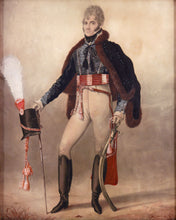Portrait of a Tenth Hussar by Dighton, 1804
- Regular price
- £2,250
- Sale price
- £2,250
- Regular price
-
- Unit price
- /per
Adding product to your cart
Overall: 56cm (22in) x 47cm (18.5in)
Watercolour on paper. Full length portrait of a dandyish officer of the Tenth Hussars attired in braided jacket with multiple rows of silver lace and regimentally specific yellow facings, crimson and gold barrel sash about the waist, fur lined pelisse over the left shoulder, breeches and hussar boots, powdered hair, in his right a cane and oddly a stovepipe type shako - perhaps an experimental replacement for the 18th century light cavalry Tarleton prior to the advent of the hussar busby. Signed and dated, ‘Dighton 1804’. Sheet: 39.5cm (16in) x 31cm (12in).
This officer’s uniform illustrates the transformation of British light dragoons into hussars that took place between 1803 to 1807. The Prince of Wales’s interests in dress, fashion and military matters drew his eye to the flamboyant uniforms of European hussars, and led him to re-equip his own regiment, the 10th Light Dragoons, as Britain’s first hussar regiment. The 10th’s officers were also fashion conscious, disorderly, hard drinking and known for their lack of morality. They included many of the Prince of Wales’ set - Beau Brummell (1778-1840) being formerly an among them. The first important parade in the new hussar uniform took place on 3 July 1807, which accords with the date of the present portrait and the anomalous headgear.
Read more
In 1808 the regiment was ordered to Spain, where it was used to screen Sir John Moore’s retreat to Corunna (1809). During that operation, it captured 100 French cavalry on Christmas Day. It also fought at Benavente, where Private Grisdall captured General Lefebvre-Desnoettes, the French cavalry’s commander-in-chief. It was evacuated with the rest of the army in January 1809, but returned to the Peninsula in 1813, fighting at Morales and Vitoria that same year, before advancing into France where it served at Orthes and Toulouse in 1814. It fought in the Waterloo campaign of 1815, where one of its patrols brought the Duke of Wellington news of the Prussian retreat at Wavre. It then joined the Army of Occupation in Paris for a year.
The Dighton family are best known for numerous portraits of City and West End characters and Regency celebrities, leading to difficulty in positively identifying which of them produced the present watercolour. Robert Dighton senior (1751-1814) the founder of the dynasty was a caricaturist who satirised lawyers, military officers, actors and actresses, as well as tailors, academics and down-at-heel types. He had three sons; Richard (1796?-1880), his father's apprentice, who continued his business from 1815 before moving to Cheltenham and Worcester; the battle-scene painter Denis Dighton (1792-1827) who received a commission in the Army in 1811 and then trained as an artist; and, Robert Dighton junior (1786-1865), who etched military portraits between 1800–09 and then made a career in the Army.






